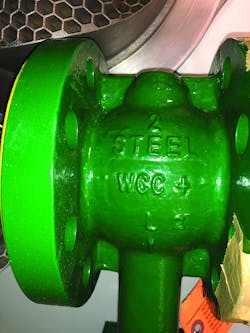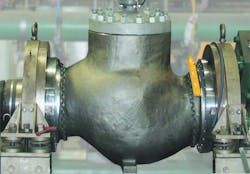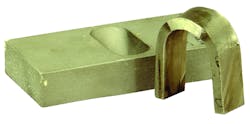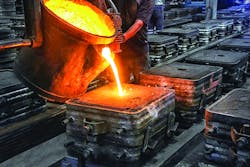Across many types of products in a variety of industries, the practice of combining assorted components from various resources around the world is the rule, not the exception. Should this be a concern for a control valve user? For example, when an end user discovers that several components are being made in China (Figure 1), should the user worry about the quality?
When dealing with a major valve vendor, the answer is "no." There shouldn’t be any room for doubt when the vendor has multiple checks and balances in place focusing on product quality to ensure control valves operate as designed, need minimal maintenance, perform safely and operate within environmental regulations.
Yet, despite such efforts by the vendor, a control valve user may have questions about global sourcing and the country of origin. This article discusses how one major control valve vendor ensures product quality. Many other control valve vendors follow the same or similar procedures.
Quality specification brings global assurance
Emerson enforces a comprehensive quality specification for its Fisher control valves that must be met by suppliers of pressure-containing and structural metal castings. The quality specification includes more than a dozen requirements that apply to the following areas:
- Supplier qualification
- Welding procedures
- Marking inspection and testing
- Tryout and sample castings
- Production castings
- Certification of compliance
Supplier qualification — Suppliers undergo a rigorous qualification process. The process thoroughly investigates a potential supplier’s ability to meet material specifications and applicable international codes and standards — as well as specific requirements related to component manufacture. In the case of castings, a foundry is considered "qualified" when it passes a critical evaluation by Fisher’s engineers.
The foundry must demonstrate a record of qualification by a third-party inspection agency and conform to various standards, such as ISO 9001:2000, ASME, A2LA, PED and others. It must pass a review of its quality program as well as on-site audits of the foundry’s processes and procedures such as welding, heat treatment and non-destructive examination. Additional proof of performance is determined by analysis of tryout castings to verify specifications are met.
Welding procedures — Welding is used during the production and upgrading of castings, such as when radiographic examination is required. Welding requirements state that procedures and welder qualifications must meet ASME Section IX (or EN ISO 15614-1 and ISO 9606-1) qualification standards. Similarly, each lot of weld filler must comply with ASME/AWS chemical analysis specifications. In Europe, compliance must be to EN499. Weld filler must have actual chemistry.
Marking inspection and testing — Valve body castings have markings (Figure 2) that identify the foundry that poured the casting and that indicate the heat code. Material identification is also typically shown on the body casting, such as CC, CF8M, CN7M and others.
Casting checks — Emerson technicians conduct both visual inspections and mechanical tests on pressure-retaining castings.
As-cast external and internal surfaces are inspected visually for unacceptable irregularities, including hot tears and cracks, shrink, sand inclusions, veining and rat tails. Mechanical testing involves a hydrostatic pressure test to confirm the leak tightness of a control valve’s pressure-retaining parts, including the body and bonnet castings. The test procedure involves a fixture that closes off cavities that would be pressurized in service and then subjects the component to the hydrostatic shell test pressure appropriate for the valve body material and class.
ASME B16.34 sets out the hydrostatic test pressure to use for steel and alloy valves. It’s calculated by multiplying the working pressure by 1.5 and rounding to the next higher 25 psig increment. Any visually detectable weeping or leaking through the pressure boundary walls that are part of the valve assembly is a mandatory cause for rejection (Figure 3).
Compliance with these specifications must be ensured, as well as with other requirements regarding materials.
Figure 2. Markings identify the foundry and materials of the valve body. These control valve bodies were cast at an Emerson-approved foundry in China.
Meeting material requirements
Valve casting integrity and quality begins with specifications that call not only for premium materials, but also for the materials that work best in the intended applications. These application requirements include strength and ductility as well as resistance to certain factors, including the makeup of the controlled fluid, operating temperature and flow velocity.
For instance, chemical composition must be controlled precisely to achieve an alloy’s intended performance level. Carbon steel castings for valves intended for use in oil and gas applications must meet NACE SP0472 recommendations that chemical composition be controlled to less than 0.43% carbon equivalency. The lower carbon content improves weldability and reduces the potential for stress cracking by hydrogen sulfide typically found in oil and gas production and processing applications.
Another example of materials tied to a specific application include those for upstream oil and gas production. Many of these applications occur in the arctic regions of Russia and Canada. For this service, castings are ASME SA 352 Grade LCC, while forgings must meet ASME SA 350 Grade LF2.
Many products with global use now comply with dual material specifications to meet ASME and European standards. For example, steel castings are specified and certified to both ASME SA216 Grade WCC and EN 10213 Grade 1.0619. Emerson often adds its own stringent requirements such as the heat treating of high nickel alloys, more demanding chemical composition or special welding procedures.
In the past, Emerson has supplemented conventional ASTM and ASME specifications to achieve the enhanced corrosion-resistance levels and high temperature capabilities provided by high-nickel alloys. This is now accomplished by the new ASTM specification A990, which addresses both material composition and quality.
Figure 3. Pressure-retaining components of a valve are subjected to hydrostatic testing to evaluate the parts’ integrity. Visible leakage or seepage through a casting means automatic rejection.
Qualifying a foundry
As part of a prospective foundry’s qualification, Emerson inspects and tests Fisher valve castings. Non-destructive testing radiography is used as a monitoring tool. ASTM A990 Class C requires radiography of the first casting of each pattern. The acceptance criterion is Level 3 for categories A, B and C. For categories D through G, no cracking, hot tears or inserts are allowed as specified in ASTM A990.
High-nickel alloy castings provide improved performance in corrosive services and elevated temperatures. However, if high-nickel castings are improperly prepared, they can pose major problems, including poor integrity, poor weldability and lower-than-expected corrosion resistance. A systematic foundry qualification process can be followed to avoid these casting difficulties.
The foundry must cast a 1-inch thick high-nickel test plate (Figure 4) that meets ASTM Material Specification A990. It’s difficult to cast because of the difference in cross-section between the base of the weld cavity (in the center) and the overall 1-inch thickness of the plate. The cavity of the poured plate is then filled with a matching composition weld material. The welder and procedure for this step must meet the standards outlined in Section IX of the ASME Boiler and Pressure Vessel Code. Test bars (3/8-inch thick) are cut from the plate and bent over a 1½-inch mandrel per ASTM A990 into a U-shape.
The bars are examined closely for cracking along the weld heat-affected zone, casting grain boundaries or dendrite boundaries. Failure to meet quality standards will result in the disqualification of the foundry from further consideration. Casting patterns must be dedicated solely to high-nickel alloy service. Use of carbon steel or a stainless-steel pattern is unacceptable due to differences in solidification properties.
Shrinkage rates for gates, risers and other accessories can vary considerably. Once the dedicated pattern equipment for each of these components has been secured, try-out castings are poured for each pattern-alloy combination. The castings are then radiographed.
The intent is to reveal any inherent casting defects — such as shrinkage — that need to be eliminated by modifying the pattern rigging.
Figure 4. In a foundry evaluation, a casting is filled with weld filler, then sliced to yield a bar for bend testing.
A qualified foundry
Emerson has used a Chinese foundry (Figure 5) to cast Fisher valve bodies for more than a decade. After an exploratory visit by procurement and manufacturing specialists, followed by an extensive qualification process, the foundry was approved and has been delivering high-quality valve body and bonnet castings to Fisher valve manufacturing sites.
To help ensure the quality of the castings it produces, the Chinese foundry has implemented international standards and has obtained certifications for German TUV and CE, Norway DNV, German Lloyd’s and American ABS, and has passed international quality system certifications of ISO 9001 and QS -9000.
The foundry has been awarded Gold Medals three times consecutively in the Beijing International Casting, Forging and Industrial Boiler Expo. It has twice received an Excellent Supplier award from Emerson.
Figure 5. This Chinese foundry meets all specifications for casting valve bodies.
Summary
Control valve users can be concerned when they learn certain valve components are not made in the U.S. or Europe, but elsewhere. Perhaps their concern stems from experience with other inferior products, such as appliances, clothes or electronics made in those countries and sold online. But if the valve parts are being supplied to a major control valve vendor that has gone to great lengths to qualify the foundry or supplier, then users can be assured the valves meet all specifications.
Brant Pfantz is the global supply chain strategy manager for Emerson’s flow control products. He is a graduate of Coe College with a degree in business administration. He has held various supply-chain-based roles during his 13-year career with Emerson.







